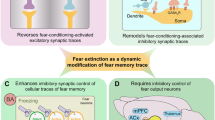Abstract
A relationship between the effects of activation and blockade of GABA receptors on extinction of a conditioned passive avoidance reaction on the one hand and the type of receptor and initial psychoemotional state on the other was found in mice. Activation of GABAA receptors with muscimol impaired extinction in normal conditions but had no effect on the delay in this process in mice with “behavioral despair” reactions. Activation of GABAB receptors with baclofen accelerated extinction of the memory of fear in mice with the depression-like state. Blockade of GABAA receptors with bicuculline had no extinction-modifying effect. Blockade of GABAB receptors with faclofen promoted retention of the expression of fear in intact mice and acceleration of extinction in “depressed” mice.
Similar content being viewed by others
References
A. V. Amikisheva and S. N. Semendyaeva, “Effects of baclofen on anxiety, sexual motivation, and olfactory perception in male mice with different psychoemotional status,” Ros. Fiziol. Zh. im. I. M. Sechenova, 92, No. 9, 1122–1134 (2006).
N. I. Dubrovina and R. Yu. Il’yuchenok, “Effects of activation of GABAA-benzodiazepine and D2 dopaminergic receptors on extinction of a conditioned passive avoidance reaction in submissive and aggressive mice,” Zh. Vyssh. Nerv. Deyat., 50, No. 6, 1007–1015 (2000).
N. I. Dubrovina and R. A. Tomilenko, “Extinction of a concentration passive avoidance reaction in mice with a depression-like state,” Ros. Fiziol. Zh. im. I. M. Sechenova, 92, No. 9, 1092–1099 (2006).
I. Akirav, H. Raizel, and M. Maroun, “Enhancement of conditioned fear extinction by infusion of the GABA agonist muscimol into the rat prefrontal cortex and amygdala,” Eur. J. Neurosci., 23, No. 3, 758–764 (2006).
H. Anisman and K. Matheson, “Stress, depression, and anhedonia: caveats concerning animal models,” Neurosci. Biobehav. Res., 29, No. 4–5, 525–546 (2005).
D. J. Berlau and J. L. McGaugh, “Enhancement of extinction memory consolidation: the role of the noradrenergic and GABAergic systems within the basolateral amygdale,” Neurobiol. Learn. Mem., 86, No. 2, 123–132 (2006).
H. Car and R. J. Wiszniewska, “Effects of baclofen and L-AP4 in passive avoidance test in rats after hypoxia-induced amnesia,” Pharmacol. Rep., 58, No. 1, 91–100 (2006).
C. Castellano, S. Cabib, and S. Puglisi-Allegra, “Psychopharmacology of memory modulation: Evidence for multiple interaction among neurotransmitters and hormones,” Behav. Brain Res., 77, No. 1–2, 1–21 (1996).
J. P. Chhatwal, K. M. Myers, K. J. Ressler, and M. Davis, “Regulation of gephyrin and GABAA receptor binding within the amygdala after fear acquisition and extinction,” J. Neurosci., 25, No. 2, 502–506 (2005).
K. A. Corcortan, T. J. Desmond, K. A. Frey, and S. Maren, “Hippocampal inactivation disrupts the acquisition and contextual encoding of fear extinction,” J. Neurosci., 25, No. 39, 8978–8987 (2005).
J. F. Cryan and A. Holmes, “The ascent of mouse: advances in modeling human depression and anxiety,” Nat. Rev. Drug Discov., 4, No. 9, 775–790 (2005).
M. Davis, K. M. Myers, J. Chhatwal, and R. K. Ressler, “Pharmacological treatments that facilitate extinction of fear: relevance to psychotherapy,” NeuroRX, 3, No. 1, 82–96 (2006).
M. R. Delgado, A. Olsson, and E. A. Phelps, “Extending animal models of fear conditioning to humans,” Biol. Psychol., 73, No. 1, 39–48 (2006).
W. Froestl, M. Gallagher, H. Jenkins, A. Madrid, T. Melcher, S. Teichman, C. G. Mondadori, and R. Pearlman, “SGS742: the first GABA(B) receptor antagonist in clinical trials,” Biochem. Pharmacol., 68, No. 8, 1479–1487 (2004).
D. P. Getova and N. G. Bowery, “Effects of high-affinity GABAB receptor antagonists on active and passive avoidance responding in rodents with gamma-hydroxybutyrolactone-induced absence syndrome,” Psychopharmacology, 157, No. 1, 89–95 (2001).
J. A. Harris and R. F. Westbrook, “Evidence that GABA transmission mediates context-specific extinction of learned fear,” Psychopharmacology (Berlin), 140, No. 1, 105–115 (1998).
S. Maren, “Building and burying fear memories in the brain,” Neurosci., 1, No. 1, 89–99 (2005).
G. Marsicano, C. T. Wotjak, S. C. Azad, T. Bisogno, B. Rammes, M. G. Cascio, H. Hermann, J. Tang, C. Hoffman, W. Zieglgansberger, C. Di Marzo, and B. Lutz, “The endogenous cannabinoid system controls extinction of aversive memories,” Nature, 418, No. 6897, 530–534 (2002).
M. R. Milad, S. L. Rauch, R. K. Pitman, and G. J. Quirk, “Fear extinction in rats: implications for human brain imaging and anxiety disorders,” Biol. Psychiatr., 73, No. 1, 61–71 (2006).
C. Mombereau, K. Kaupmann, W. Froestl, G. Sansig, H. van der Putten, and J. F. Cryan, “Genetic and pharmacological evidence of a role for GABA(B) receptors in the modulation of anxiety-and antidepressant-like behavior,” Neuropsychopharmacology, 29, No. 6, 1050–1062 (2004).
A. Pilc and G. Nowak, “GABAergic hypotheses of anxiety and depression: focus on GABA-B receptors,” Drug Today, 41, No. 11, 755–766 (2005).
L. E. Schechter, R. H. Ring, C. E. Beyer, A. A. Hughes, X. Khawaja, J. E. Malbert, and S. Rozenzweig-Lipson, “Innovative approaches for the development of antidepressant drugs: current and future strategies,” NeuroRX, 2, No. 4, 590–611 (2005).
J. Shumake, D. Barrett, and F. Gonzalez-Lima, “Behavioral characteristics of rats predisposed to learned helplessness: reduced reward sensitivity, increased novelty seeking, and persistent fear memories,” Behav. Brain Res., 164, No. 2, 222–230 (2005).
B. K. Yee, J. Hauser, V. V. Dolgov, R. Keist, H. Mohler, U. Rudolph, and J. Feldon, “GABA receptors containing the alpha5 subunit mediate the trace effect in aversive and appetitive conditioning and extinction of conditioned fear,” Eur. J. Neurosci., 20, No. 7, 1928–1936 (2004).
Author information
Authors and Affiliations
Additional information
__________
Translated from Rossiiskii Fiziologicheskii Zhurnal imeni I. M. Sechenova, Vol. 93, No. 11, pp. 1285–1291, November, 2007.
Rights and permissions
About this article
Cite this article
Dubrovina, N.I., Zinov’ev, D.R. Contribution of GABA receptors to extinction of memory traces in normal conditions and in a depression-like state. Neurosci Behav Physi 38, 775–779 (2008). https://doi.org/10.1007/s11055-008-9045-y
Received:
Published:
Issue Date:
DOI: https://doi.org/10.1007/s11055-008-9045-y




